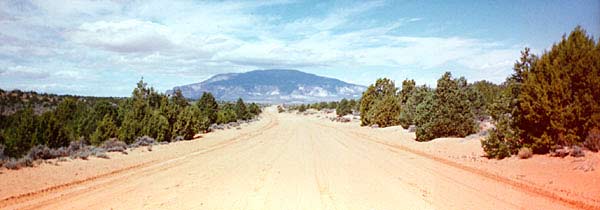

Navajo Mountain [Naatsis'áán, meaning Head of the Earth] straddles the Arizona-Utah border and rises to a height of 10388 ft. Two trails (each 14 miles long) to the largest natural arch in the world, Rainbow Bridge [Tsé naní'áhí], begin near this mountain. Neither trail is maintained and both cross rugged and incomparable scenery.
The rugged nature of the land here and the fact that Navajo Mountain [Naatsis'áán] provides a natural shield, allowed a small band of Navajos to find a safe haven here when many of their fellow tribesmen were removed to the Bosque Redondo in 1864. Rainbow Bridge [Tsé naní'áhí] was discovered by Blind Salt Clansman of this group (and also possibly independently by others from other Native American tribes) while rounding up horses. As the Navajo are fortunate enough to realize that the universe around them is filled by the holy, it was natural to interpret this incredible structure as a petrified rainbow. In fact, it is two petrified rainbows, one male and one female, in perfect union. This is only natural since this arch lies very close to the confluence of the San Juan [Tooh] (male) and the Colorado [Tóníts'ósíkooh] (female) rivers where the Cloud and Rain People were born. Prior to the construction of the dam, Navajo chanters would make pilgrimages to Rainbow Bridge [Tsé naní'áhí] and the nearby confluence of the San Juan [Tooh] and Colorado [Tóníts'ósíkooh] rivers, perform ceremonies to bring rain and leave offerings to the Holy People [dighin diné].
The filling of the lake covered the confluence of these rivers, considered to be male and female, joining there, and from which the Cloud and Rain People were born. After the construction of the Marina, the Navajo [Diné] no longer feel comfortable there and have discontinued the ceremonies.
Unfortunately, because there has been easy access to the arch since the construction of Glen Canyon Dam and the filling of Lake Powell (John Wesley Powell must be planning revenge on those who perpetrated this disaster in his name!), those who come over water have made a trash heap of the area near the Rainbow Bridge Marina, allowed by the Park Service to operate there. The area is now overrun with hordes of vacationers, their boats and their trash.
Navajo Mountain [Naatsis'áán], where Monster Slayer [Naayéé' Neizghání] moved in order to protect this band of Navajo, has not been left alone by the dominant culture either. A radio tower has been built on the top of Navajo Mountain [Naatsis'áán], by the sacred Pool. The radio tower was placed on the location used for ceremonies of the Moisture-pleading-way, the very Head of the Earth. These ceremonies were also discontinued after the radio tower was located there.
The comments on John Wesley Powell were made by Southwest historian Lawrence Clark Powell
in an interview on KUAT radio in Tucson, AZ.
The comments on Glen Canyon, before and after the dam, are from Bruce Berger's book
There was a River published by Northland Press.
A short history of the Navajo Mountain area is available from the The Utah History Encyclopedia.

References
 |